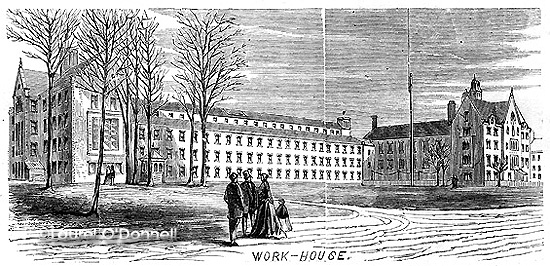|
|
Chapter VI
Institutions of Blackwell's Island.
The New York Workhouse
 For the proper administration of punitive justice, a variety of institutions are required. Hence, we have the State Prison, for the long confinement of persons guilty of the higher crimes; the County Jail or the Penitentiary for criminals not yet as deeply depraved as the preceding; the House of Refuge, or the Juvenile Asylum for vicious, truant, and vagrant youth; and to these the authorities of New York have added the Workhouse, for vagrant and dissipated adults. The building is situated on Blackwell's Wand, between the Almshouse department and that devoted to the Lunatic Asylum. The first effectual step taken for establishment of this Institution, was at a meeting of the Board of Aldermen June 26, 1848, when Clarkson Crolius presented an able communication on the subject, which was referred to a special committee of three. The board of Assistant Aldermen also appointed a committee to assist in the deliberations. On the 12th of February, 1849, the committee presented a voluminous report in favor of establishing the Workhouse. On the recommendation of the Common Council, the Legislature passed the act for its establishment April 11, 1849, and the department was duly organized during the following summer, the first commitment to it from the court occurring June 14, 1849. The original act contained no provision for buildings, and the inmates were for some time boarded at the Almshouse. The corner stone of the edifice was laid November 2, 1850, by Mayor Woodhull, and the building completed several years afterwards under the administration of the Ten Governors. The surface around it, now so smooth, was originally exceedingly broken, and more than a thousand cubic yards of rock were removed in preparing the site for the southern wing. The edifice is a vast longitudinal structure, consisting of a northern and a southern wing, with a large four-story central portion, and a traverse section containing work-shops extending across the end of each wing. The edifice is constructed in part of hewn stone, and partly of rubble masonry. The entire length is 680 feet, or more than one-eighth of a mile. The expense of its erection was at first estimated at $75,000, as much convict help was employed, though a larger sum was required to complete it. The central building contains the kitchen, store-rooms, offices, private apartments for the superintendent and others, and a spacious and elegant chapel, in which service is statedly conducted by the chaplains. |
|
247
:: Previous Page :: Next Page ::
:: Table of Contents :: :: New York State :: :: History Readings :: Books & articles appearing here are modified adaptations
from a private collection of vintage books & magazines. Reproduction of these pages is prohibited without written permission. © Laurel O’Donnell, 1996-2006.
|
|

